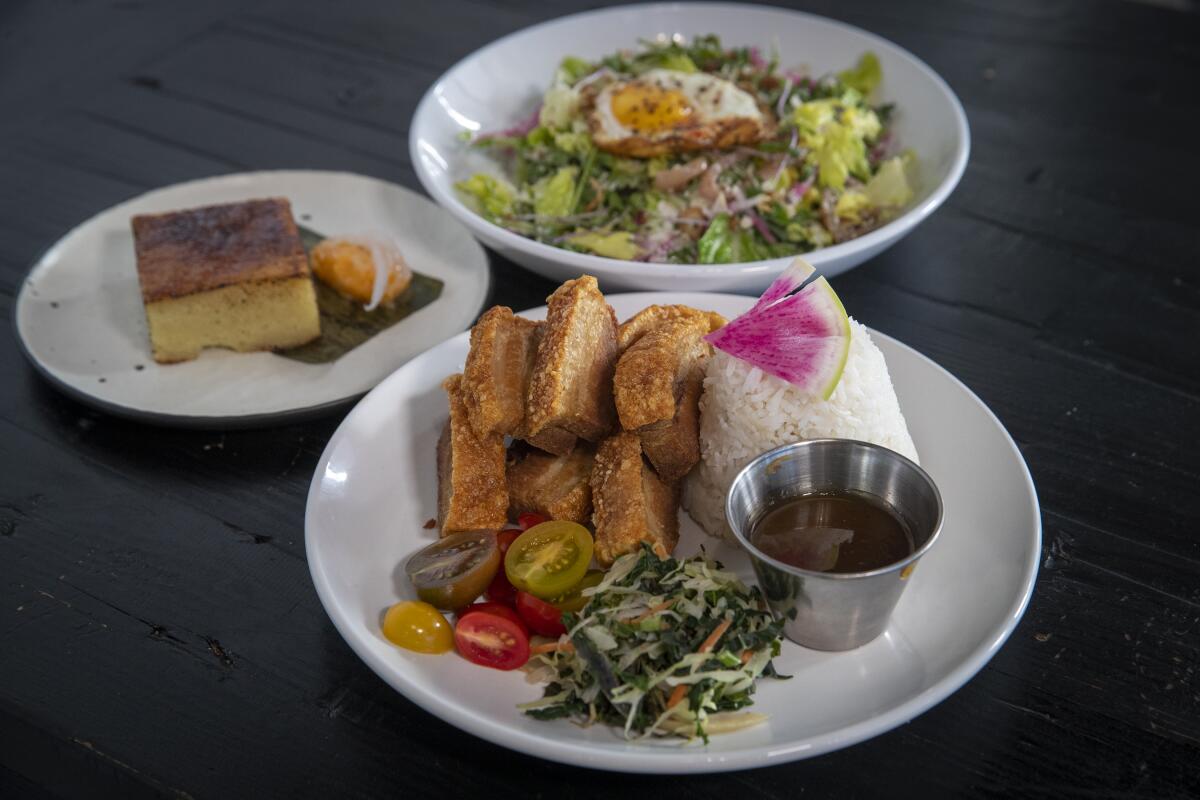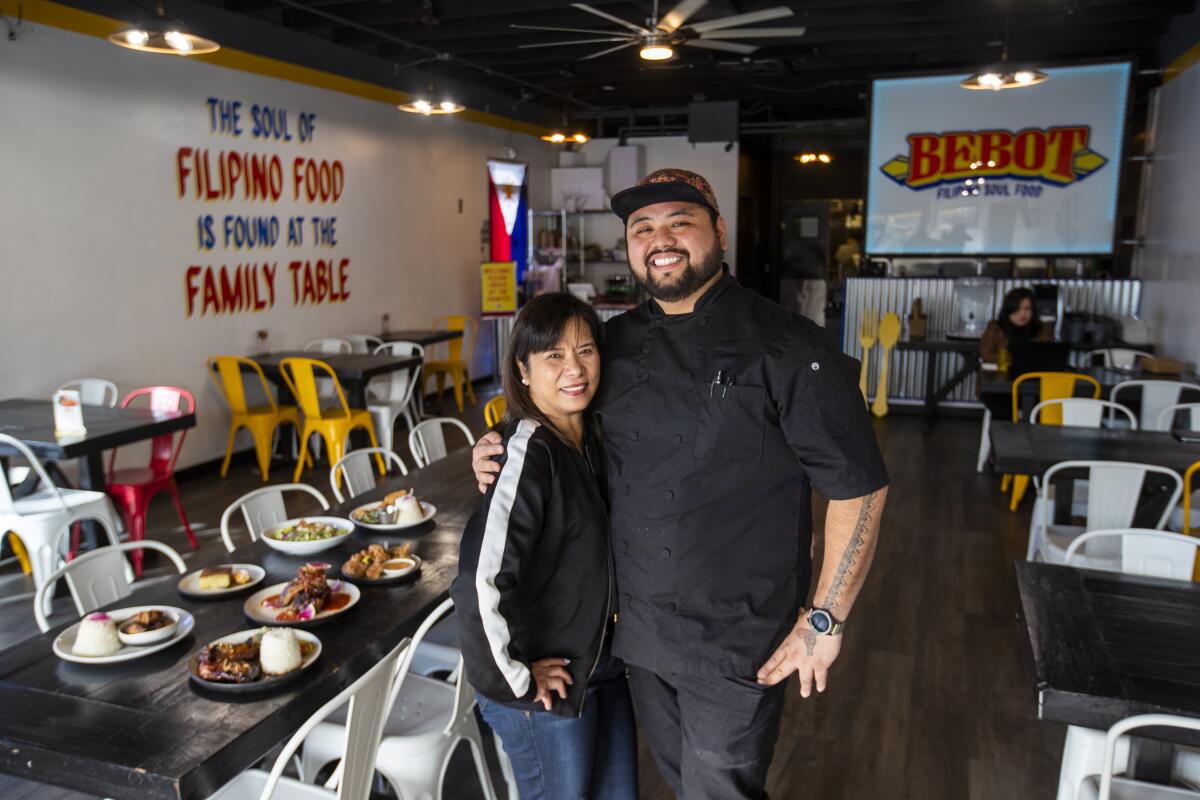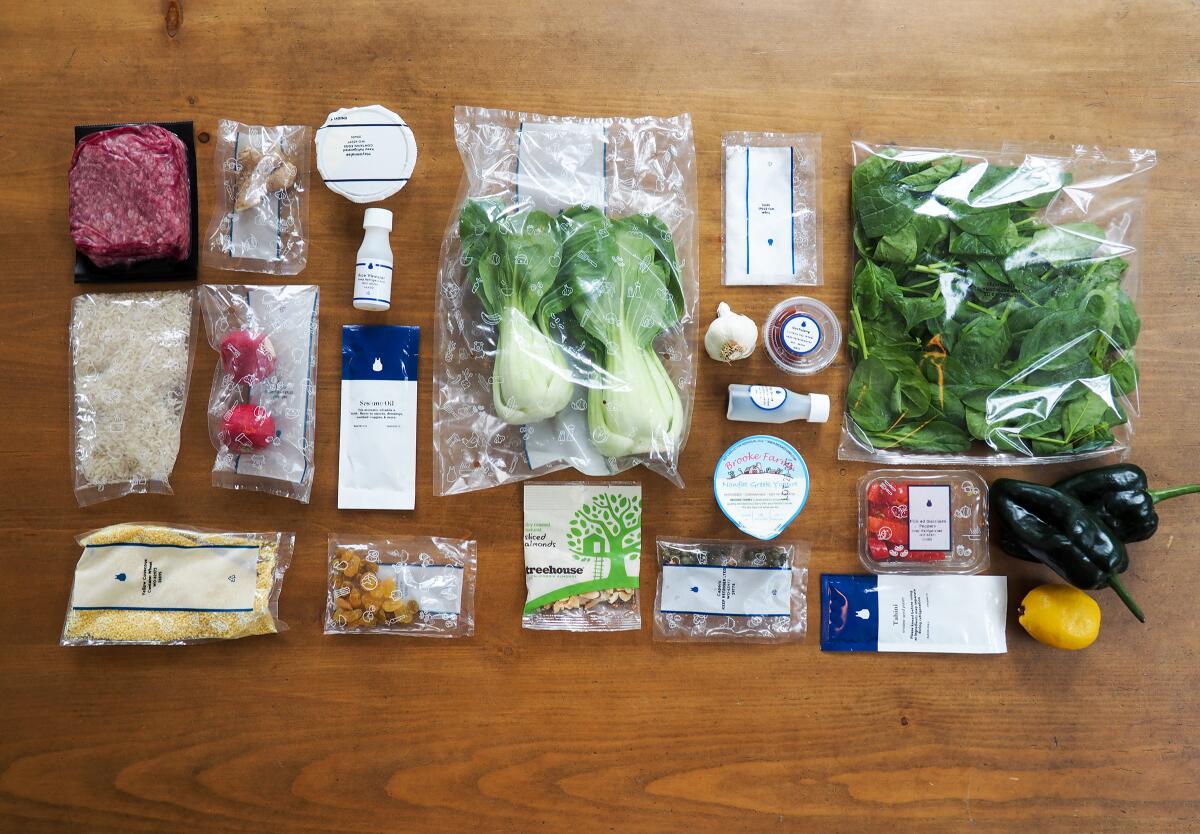A ‘Filipino soul food’ restaurant is reborn as a community kitchen

- Share via
My first restaurant review of the year was about Bebot Filipino Soul Food, the sunny counter-service café that opened at the edge of Long Beach’s 4th Street Corridor about six months ago.
Bebot is also where I had my first restaurant meal of 2020, a photogenic New Year’s brunch of longanisa-swaddled Scotch eggs; lavender-colored ube-mochi waffles smeared with coconut jam; and butter-rich bibingka brûlée.
Four months later, that meal sounds impossibly extravagant — especially the part about eating it in a well-lighted dining room surrounded by other people.
Eat your way across L.A.
Get our weekly Tasting Notes newsletter for reviews, news and more.
You may occasionally receive promotional content from the Los Angeles Times.
I checked in with Bebot owner and chef AC Boral this week to see how his restaurant has fared since the coronavirus outbreak shut down dining rooms in California and beyond.
“Our sales nosedived about 80% in the first weeks of quarantine,” Boral said.
The drop meant he had to lay off much of his team. At the beginning of March, the restaurant had 10 employees; now, he’s down to three, including himself.
“I’m everything now. I’m cashier, I’m running deliveries, I’m washing dishes,” he said.
Boral recently closed his restaurant for about two weeks to regroup. (It has since reopened for takeout, delivery and curbside pickup.)

Boral spent part of the hiatus working with Long Beach’s Filipino Migrant Center, a nonprofit group that works with low-income and undocumented Filipino families across Southern California.
That was the birth of Bebot Community Kitchen, his effort to help feed vulnerable families during the crisis.
Many of the families he cooks for don’t have a safety net or access to unemployment benefits, relying on family and community groups like the Filipino Migrant Center to cope with sudden job loss or illness.
It started with 22 family-size meals — takeaway boxes packed with enough rice, pancit and lumpia to feed about four to six family members. His restaurant has donated more than 250 hot meals.
The need for food assistance is growing as more people lose their jobs, Boral said.
“I’m in a position where I have resources. I have a full kitchen, the buying power to buy things in bulk, and a staff,” he said. “There’s a huge need and a community that’s underserved and overlooked.”
Helping others has steadied him during the crisis, he said.
For now, Boral said there’s nothing to do but keep moving forward.
“I’ve come to terms with the brutal honest truth that I don’t know if I’ll have this restaurant a year from now,” he said.
That realization impelled him to launch the community kitchen, which will feed families every week for as long as he can sustain the program.
“While I do have this space, I’m going to push out as many meals as I can,” he said. “I fought to get this kitchen, and I fought to get this space. I’m going to make the most of it while I have it.”
Enjoying this newsletter? Consider subscribing to the Los Angeles Times
Your support helps us deliver the news that matters most. Become a subscriber.
Ask the Critics
What’s been your favorite takeout since the shutdown?
— Amy, Facebook
This is the question I have gotten most often in recent weeks, and I am going to give you a cop-out answer: produce boxes.
Several L.A.-area restaurants have partnered with local farmers to sell bulk produce boxes directly to consumers, a model that’s proven enormously popular beyond the usual farmers market crowd (but which many farmers say is barely helping them stay in business). I’ve never seen my Instagram feed so flush with besotted produce-lovers who are documenting everything from leafy bundles of chard to parcels of lustrous kumquats.
I bought my first produce box two weeks ago and unpacked it with all the restraint of a small child opening birthday presents. Part of the fun is figuring out what to cook with the bounty of beautiful local produce. Ben Mims to the rescue: Check out his guide to how to cook from your produce box.
Have a question for the critics?
Our stories
— Did you catch Bill Addison’s round-up of special-occasion takeout?
— Fresh-food meal kits are in high demand these days. Jenn Harris kitchen-tested seven of the most popular kits.
— The PPP, a Small Business Administration loan program, was supposed to give small businesses financial relief, writes Lucas Kwan Peterson. So why are so many independent business owners bewildered, disappointed and angry?
— Garrett Snyder has three simple and flavorful one-pan meals that can be pulled together in less than 30 minutes using the canned meats you’ve been secretly hoarding this whole time.
— Genevieve Ko has an indispensable kitchen trick: How to use brown butter to make mac and cheese even better.
— Fish with shatteringly crisp skin is a perfect food, writes Ben Mims. The secret: Don’t touch your salmon.
— Finally, I mentioned that produce boxes are connecting people to high quality produce, but they can also be a logistical nightmare for farmers. Amy Scattergood reports on how California farmers forced to reinvent their business models are coping during the COVID-19 outbreak.

Eat your way across L.A.
Get our weekly Tasting Notes newsletter for reviews, news and more.
You may occasionally receive promotional content from the Los Angeles Times.



